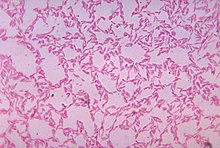FCB superphylum
| FCB superphylum | |
|---|---|

| |
| Bacteroides spp. | |
| Scientific classification | |
| Domain: | Bacteria |
| Clade: | FCB group |
| Phyla | |
| |
| Synonyms | |
|
Sphingobacteria Cavalier-Smith, 1987[1] | |
The FCB group is a superphylum of bacteria named after the main member phyla Fibrobacterota, Chlorobiota, and Bacteroidota. The members are considered to form a clade due to a number of conserved signature indels.[2]
Cavalier-Smith calls the equivalent grouping a phylum by the name of Sphingobacteria. It contains the classes Chlorobiota, Fibrobacterota, Bacteroidota, and Flavobacteria. However, this megaclassification is not followed by the larger scientific community.[3][4][5]
| FCB group[2][6][7] | 16S rRNA based LTP_12_2021[8][9][10] | GTDB 07-RS207 by Genome Taxonomy Database[11][12][13] | |||||||||||||||||||||||||||||||||||||||||||||||||||||||||
|---|---|---|---|---|---|---|---|---|---|---|---|---|---|---|---|---|---|---|---|---|---|---|---|---|---|---|---|---|---|---|---|---|---|---|---|---|---|---|---|---|---|---|---|---|---|---|---|---|---|---|---|---|---|---|---|---|---|---|---|
|
An analogous situation is seen with the PVC group/Planctobacteria.

Notes
[edit]See also
[edit]References
[edit]- ^ Cavalier-Smith, T. (1987). The origin of cells: a symbiosis between genes, catalysts and membranes. Cold Spring Harbor Symposia on Quantitative Biology 52, 805-24, [1], [2].
- ^ a b Gupta, R. S. (2004). "The Phylogeny and Signature Sequences Characteristics of Fibrobacteres, Chlorobi, and Bacteroidetes". Critical Reviews in Microbiology. 30 (2): 123–143. doi:10.1080/10408410490435133. PMID 15239383. S2CID 24565648.
- ^ Cavalier-Smith T (2006). "Rooting the tree of life by transition analyses". Biol. Direct. 1: 19. doi:10.1186/1745-6150-1-19. PMC 1586193. PMID 16834776.
- ^ Krieg, N.R.; Ludwig, W.; Whitman, W.B.; Hedlund, B.P.; Paster, B.J.; Staley, J.T.; Ward, N.; Brown, D.; Parte, A. (November 24, 2010) [1984(Williams & Wilkins)]. George M. Garrity (ed.). The Bacteroidetes, Spirochaetes, Tenericutes (Mollicutes), Acidobacteria, Fibrobacteres, Fusobacteria, Dictyoglomi, Gemmatimonadetes, Lentisphaerae, Verrucomicrobia, Chlamydiae, and Planctomycetes. Bergey's Manual of Systematic Bacteriology. Vol. 4 (2nd ed.). New York: Springer. p. 908. ISBN 978-0-387-95042-6. British Library no. GBA561951.
- ^ Classification in LPSN; Parte, Aidan C.; Sardà Carbasse, Joaquim; Meier-Kolthoff, Jan P.; Reimer, Lorenz C.; Göker, Markus (1 November 2020). "List of Prokaryotic names with Standing in Nomenclature (LPSN) moves to the DSMZ". International Journal of Systematic and Evolutionary Microbiology. 70 (11): 5607–5612. doi:10.1099/ijsem.0.004332.
- ^ Emiley A Eloe-Fadrosh et al. 2017, Global metagenomic survey reveals a new bacterial candidate phylum in geothermal springs. Nature Communications 7 · January 2016 DOI: 10.1038/ncomms1047
- ^ Kirkegaard, Rasmus Hansen; Dueholm, Morten Simonsen; McIlroy, Simon Jon; Nierychlo, Marta; Karst, Søren Michael; Albertsen, Mads; Nielsen, Per Halkjær (October 2016). "Genomic insights into members of the candidate phylum Hyd24-12 common in mesophilic anaerobic digesters". The ISME Journal. 10 (10): 2352–2364. doi:10.1038/ismej.2016.43. ISSN 1751-7370. PMC 5030696. PMID 27058503.
- ^ "The LTP". Retrieved 23 February 2021.
- ^ "LTP_all tree in newick format". Retrieved 23 February 2021.
- ^ "LTP_12_2021 Release Notes" (PDF). Retrieved 23 February 2021.
- ^ "GTDB release 07-RS207". Genome Taxonomy Database. Retrieved 20 June 2022.
- ^ "ar53_r207.sp_label". Genome Taxonomy Database. Retrieved 20 June 2022.
- ^ "Taxon History". Genome Taxonomy Database. Retrieved 20 June 2022.
- ^ Hug, Laura A.; Baker, Brett J.; Anantharaman, Karthik; Brown, Christopher T.; Probst, Alexander J.; Castelle, Cindy J.; Butterfield, Cristina N.; Hernsdorf, Alex W.; Amano, Yuki; Ise, Kotaro; Suzuki, Yohey; Dudek, Natasha; Relman, David A.; Finstad, Kari M.; Amundson, Ronald; Thomas, Brian C.; Banfield, Jillian F. (11 April 2016). "A new view of the tree of life". Nature Microbiology. 1 (5): 16048. doi:10.1038/nmicrobiol.2016.48. PMID 27572647.
